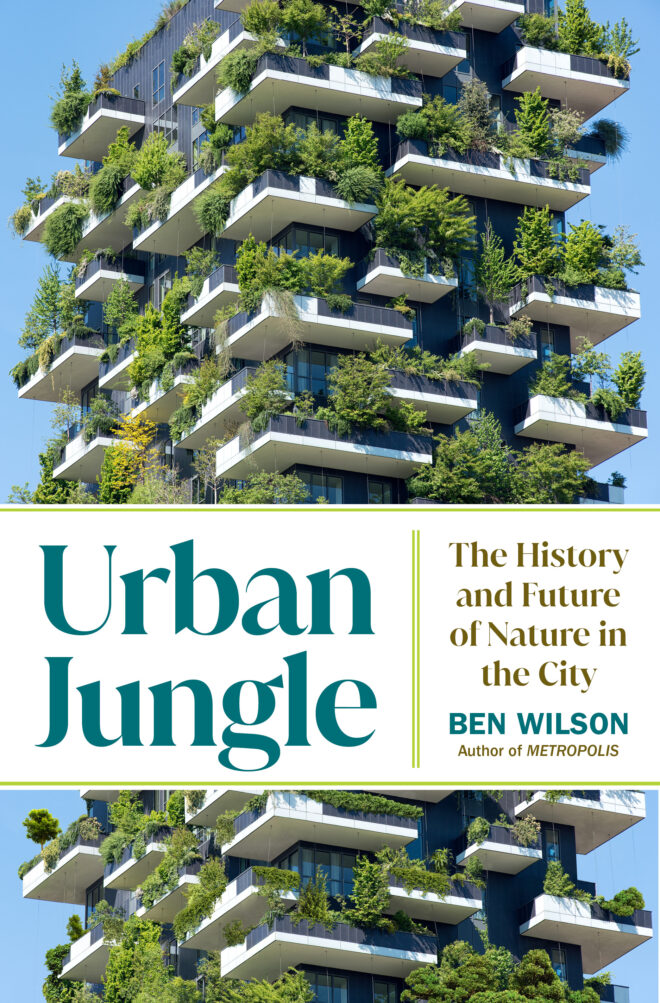
Book Review: Urban Jungle: The History and Future of Nature in the City
Contributor
- Topics: Growing for Biodiversity
Summer 2023
The world’s population raced past 8 billion this year. By 2050 more than two-thirds of the people on Earth, 7 billion people, will be concentrated in cities.
We can only hope they will be urban jungles, full of biodiversity, and wildlife corridors, the “green metro system” connecting cities to edgeland climate buffers. In his new book, Urban Jungle: The History and Future of Nature in the City, Ben Wilson urges us to be “thinking bigger, reconsidering cities as places packed with life and ecological benefits.”
Wilson has given us an insightful look into the development of cities, a well-researched urban history. He notes that despite industrialization and concrete jungles, those who live in cities have always sought a sense of “rus in urbe,” the countryside in the city, recognizing the human need for nature to be part of our lives no matter where we live.
From the rice paddies surrounding Tokyo to the royal hunting parks of London to the walled gardens of ancient Persia and Aztec desert gardens honoring their ancestors, cities have sought a connection to nature.
Now as humanity increasingly concentrates in cities, we need to recognize them as novel ecosystems, as ecotones with more biodiversity than the surrounding countryside. The human-made ecosystems we have created in cities—with favorite plants that we have brought with us from around the globe for food, medicine, and ornamental beauty—have created urban biomes that can be a salvation of resiliency if we recognize them as ecotones and engineer them toward designed ecology.

This is already happening in cities around the world and Wilson cites numerous examples. Singapore has turned itself into a city in a garden, with 56 percent of its surface covered in vegetation. After World War II, Berlin simultaneously incorporated massive heaps of rubble into rock gardens and retained more than 7,000 acres of community garden allotments that residents began during the war. New York City transformed the infamous Fresh Kills Landfill into a “lifescape” rewilding success story, and the innovative landscape architect Kate Orff introduced living oyster mounds as “oyster-tecture,” engineered protection in the harbor against storm surges.
The edges of cities become their own ecotones, where different ecosystems collide, so we should think of them as ecological buffer zones, not greenbelts that are simply parks or recreational facilities. These edgelands need to be designed ecologies incorporating existing native habitats and biomes into the human environment, using small farms, urban forests with functioning watersheds, bioswales, and storm drains that percolate precipitation back into the earth to create sustaining ecosystem buffers.
We can connect these edges with a green metro system of wildlife stepping stone corridors through cities. Environmental activist and cartographer Molly Burhans created geographic information system tools overlaying Catholic Church lands, public lands, and vacant city properties with maps of topography, weather maps, wildlife migration patterns, and wetlands to visualize a true green infrastructure.
Our own gardens are a key element to green infrastructure, connecting nature to city life. We are already seeing a movement away from manicured lawns—and the wasted green space they represent—to more wildness, urban meadows, and actual habitat, especially in front yards where we can connect with neighbors and street trees. Let’s all think #LifeNotLawn.
These designed ecologies—gardens—are adapting plants to the built landscape and radically changed native ecosystems that cities create. Native plants may not always be the best choices for urban gardens, but many plants do adapt. As Wilson writes, “being honest with ourselves about the reality of the humanmade ecosystem we have built, welcoming vegetation pre-adapted to this most artificial of environments.”
In the various parts of the summer-dry climate where most of us garden, that means considering the many, many plants from other summer-dry and mediterranean climates of the world that are pre-adapted to our cities, “cosmopolitan urbanites.” As the climate changes, it will be increasingly important for gardeners to incorporate new plants into these novel ecosystems.
There is a lot of untapped green potential in urban areas and an already incredible amount of biodiversity. Just ask the bees. A Boston study showed that urban bees visited 411 plant species to make honey as opposed to 82 plant species for rural bees.
The abandoned lots, highway corridors, street medians, rail lines and utility easements may not be intentional habitats, but connecting them with gardens, public and private, rooftops and community gardens, corporate campuses and cemeteries, churches and schoolyards—as a combined whole—form the green infrastructure that cities have under their control.
Cities can be livable and ecologically resilient. There can be rus in urbe. Urban jungles need to be deliberately part of the larger green infrastructure of garden Earth, on behalf of the people who live within them and the Earth as a whole.
“The quest for biodiversity and sustainability should, as its ultimate goal, make the environment, in which we reside the best it possibly can be for us.”
Order your copy of Urban Jungle from the Publisher, Penguin Random House by clicking here.












Responses